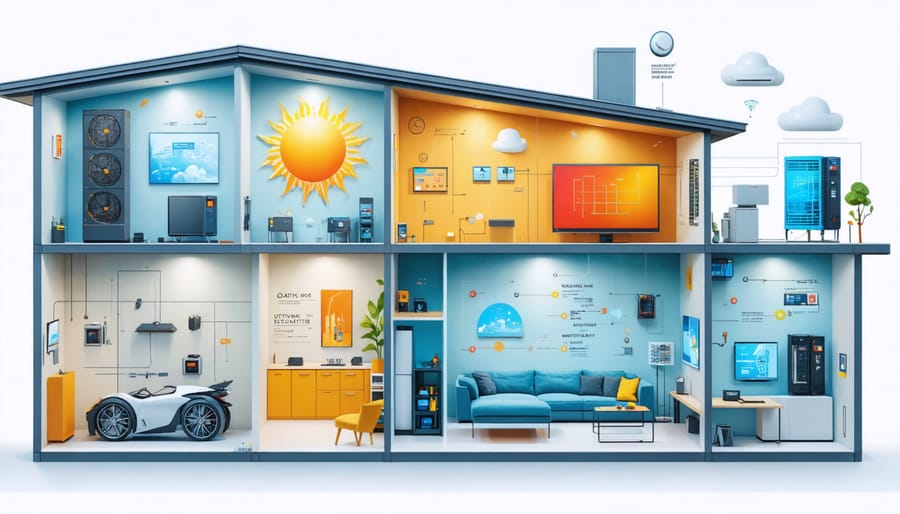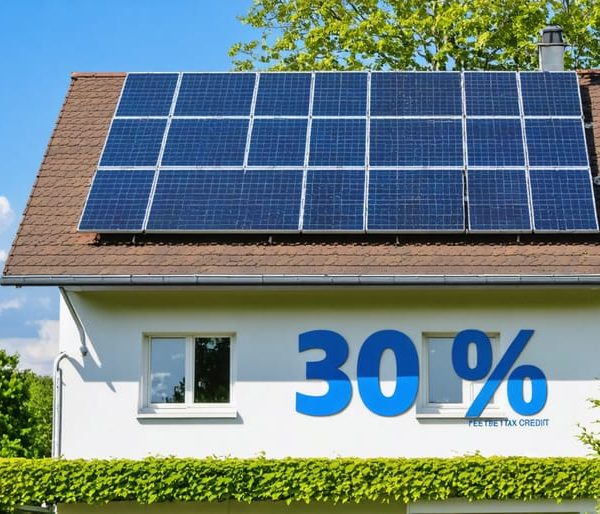Safe and Smart: Essential Lithium-Ion Battery Storage Requirements for Your Home System
Proper storage of lithium-ion batteries dramatically extends their lifespan and ensures optimal performance in your home energy storage system. Maintain temperatures between 59-77°F (15-25°C) in a dry, well-ventilated space away from direct sunlight and heat sources. Install fire-resistant barriers and smoke detectors nearby, keeping batteries at least 12 inches from walls and other equipment. Store at 30-50% charge when not in use for extended periods, avoiding complete discharge or constant full charge states.
The growing adoption of residential battery storage has made proper handling essential for both safety and performance. Modern lithium-ion batteries represent a significant investment in sustainable living, with proper storage practices directly impacting their 10-15 year lifespan. Understanding these requirements isn’t just about protection—it’s about maximizing your return on investment while ensuring your family’s safety.
This practical approach to battery storage combines industry best practices with real-world application, helping homeowners confidently manage their energy storage systems while maintaining peak performance and safety standards.
Temperature Control: The Key to Battery Longevity
Ideal Temperature Ranges
Keeping your lithium-ion batteries at the right temperature is crucial for their performance and longevity. The sweet spot for these batteries is between 20°C and 25°C (68°F to 77°F). Think of it as the same comfortable room temperature that you enjoy!
When batteries get too hot (above 30°C/86°F), they age faster and lose capacity more quickly. For every 10°C increase above room temperature, your battery’s lifespan could be cut in half. On the flip side, extremely cold temperatures (below 0°C/32°F) can significantly reduce the battery’s ability to deliver power when you need it.
To maintain optimal performance, avoid storing your batteries in places that experience temperature extremes, such as uninsulated garages, outdoor sheds, or areas with direct sunlight. If you live in a region with harsh winters or hot summers, consider installing your battery system in a temperature-controlled space like a basement or utility room.
Remember that consistent temperatures are just as important as the actual temperature range. Frequent temperature swings can stress the battery and reduce its overall lifespan.
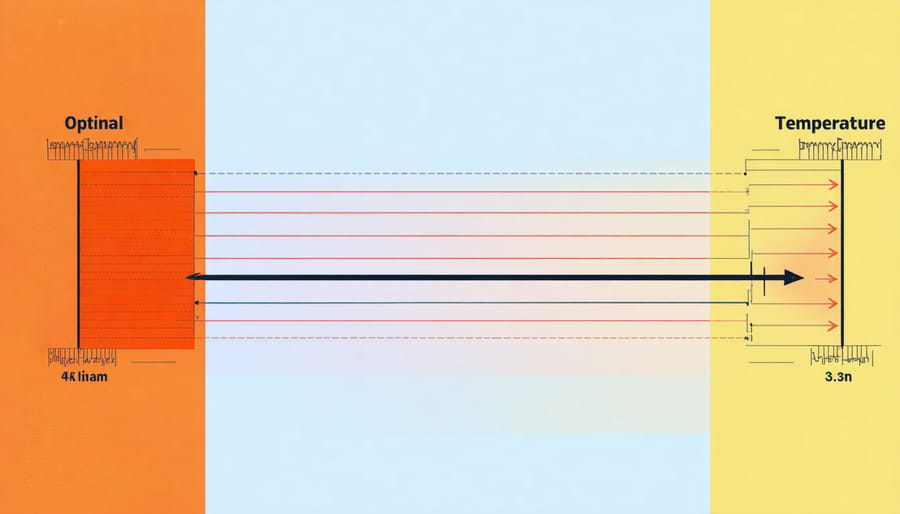
Ventilation Requirements
Proper ventilation is crucial for maintaining safe and efficient lithium-ion battery storage. Your battery storage area needs a well-designed airflow system to prevent heat buildup and maintain optimal operating temperatures. A good rule of thumb is to ensure at least 1 foot of clearance around all sides of the battery unit for adequate air circulation.
Install a ventilation fan rated for at least 100 cubic feet per minute (CFM) for every 100 square feet of storage space. The fan should operate continuously or be temperature-controlled to activate when the room reaches 77°F (25°C). For larger installations, consider a dual-fan setup with one intake and one exhaust fan to create proper air exchange.
Keep vents clear of obstructions and regularly check that air filters are clean. If you’re installing batteries in an enclosed space, add vents near the floor and ceiling to create natural convection cooling. For added safety, install a temperature monitoring system that alerts you if ventilation isn’t maintaining proper conditions.
Remember that batteries perform best in cool, dry conditions. Good ventilation not only prevents overheating but also helps manage humidity levels, extending your battery system’s lifespan.
Space and Location Requirements
Clearance and Access
When storing lithium-ion batteries, proper clearance and accessibility are crucial for both safety and maintenance. Keep a minimum clearance of 3 feet (1 meter) around all sides of your battery system to ensure adequate ventilation and easy access for maintenance. This spacing also allows heat to dissipate effectively and prevents the risk of overheating.
For indoor installations, ensure the battery storage area is easily accessible through doorways and hallways. Follow proper installation guidelines to maintain clear pathways for emergency access and routine maintenance checks. If you’re installing multiple battery units, maintain at least 12 inches of space between them to prevent heat buildup and allow for proper air circulation.
Consider mounting height carefully – the battery system should be installed at a comfortable working height, typically between 4 and 5 feet from the ground. This placement makes it easier to read monitoring displays and access controls. For garage installations, ensure the battery system doesn’t interfere with vehicle parking or movement.
Keep the area in front of the battery system clear of storage items, furniture, or equipment. This unobstructed space is essential for quick access during maintenance and emergency situations.
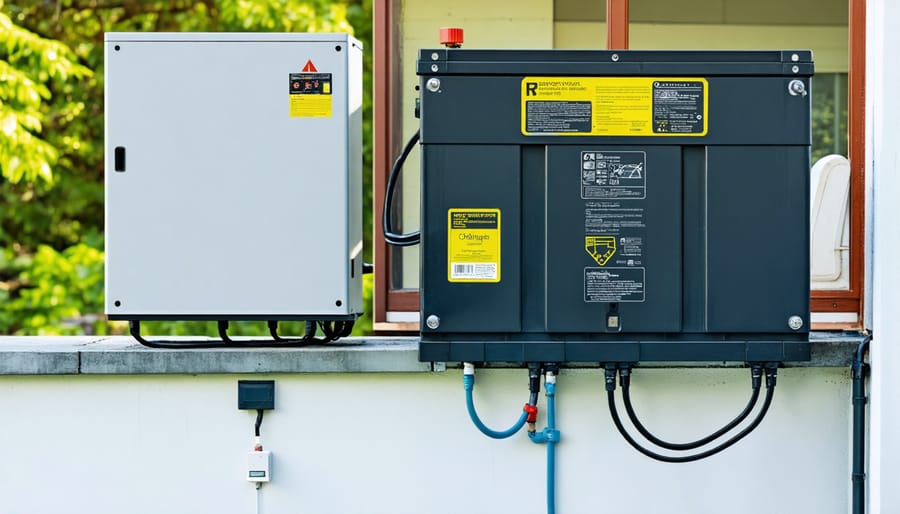
Structural Support
Proper structural support is crucial when installing lithium-ion battery systems, as these units can be surprisingly heavy. A typical home battery system can weigh anywhere from 200 to 500 pounds, requiring careful consideration of your mounting location. For wall-mounted installations, ensure the wall can support the battery’s weight – concrete or solid brick walls are ideal, while drywall usually requires additional reinforcement.
When mounting on the floor, verify that the surface is completely level and can handle the concentrated weight. Most manufacturers recommend a concrete pad or reinforced platform that’s slightly elevated to prevent water contact. Keep in mind that the mounting area should have enough clearance around all sides for proper ventilation and maintenance access.
For multi-battery installations, consider the cumulative weight and distribution. Professional installers typically use heavy-duty mounting brackets and anchors rated for at least 1.5 times the battery system’s weight. The mounting location should also be easily accessible but secure from unauthorized access.
Don’t forget to factor in additional space and support for accompanying equipment like inverters and control systems. Regular structural inspections are recommended to ensure mounting integrity over time, especially in areas prone to seismic activity.
Safety and Protection Measures
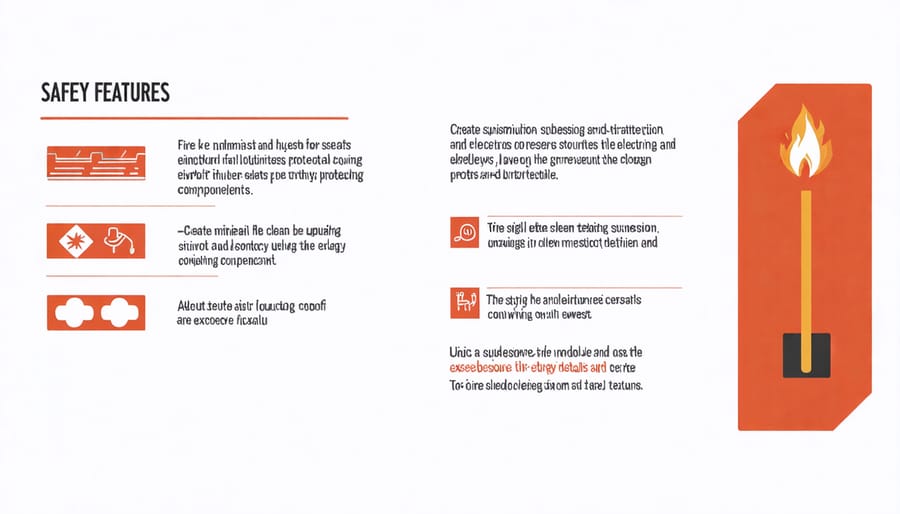
Fire Safety Requirements
Fire safety is a crucial aspect of lithium-ion battery storage that should never be overlooked. Every storage area must be equipped with appropriate fire detection and suppression systems to ensure maximum safety. Install smoke detectors specifically designed for battery fires, as these can detect potential issues before they escalate into serious problems.
A properly designed fire suppression system should include Class D fire extinguishers, which are specifically rated for metal and battery fires. Traditional water-based systems aren’t suitable for lithium-ion battery fires, as they can actually make the situation worse. Instead, consider installing a clean agent fire suppression system that uses non-conductive materials.
Create clear evacuation routes and mark them with visible signage. Keep emergency contact numbers, including the fire department and battery manufacturer’s emergency line, posted in easily accessible locations. Maintain a minimum three-foot clearance around battery units to prevent fire spread and allow easy access for emergency responders.
Regular maintenance of fire safety equipment is essential. Schedule monthly checks of smoke detectors, fire extinguishers, and suppression systems. Train all household members or facility staff on proper emergency procedures, including how to safely evacuate and whom to contact in case of a battery-related incident.
Remember to store batteries away from flammable materials and ensure proper ventilation to prevent the accumulation of potentially dangerous gases.
Electrical Protection
Proper electrical protection is crucial for your lithium-ion battery storage system to ensure safe operation and longevity. Every installation must comply with electrical safety requirements and include multiple layers of protection.
Start with a dedicated circuit breaker that matches your battery system’s specifications. This acts as your first line of defense against electrical overload. Most residential systems require a 40-60 amp breaker, but always consult your battery manufacturer’s guidelines for exact specifications.
Install a proper disconnect switch between your battery system and main electrical panel. This allows you to quickly isolate the battery system during maintenance or emergencies. Make sure it’s easily accessible and clearly labeled for quick identification.
Your battery system should also include:
– Short circuit protection
– Ground fault protection
– Overcurrent protection devices
– Surge protection
For added safety, consider installing a battery management system (BMS) if it’s not already built into your battery unit. The BMS monitors voltage levels, temperature, and current flow, automatically shutting down the system if it detects dangerous conditions.
Remember to use properly rated cables and connectors, ensuring all connections are tight and secure. Loose connections can create heat and pose fire risks. Regular inspection of these components should be part of your maintenance routine.
Maintenance Access Requirements
Regular maintenance is essential for keeping your lithium-ion battery storage system operating safely and efficiently. Plan for easy access to your battery unit with a minimum clearance of 3 feet on all sides. This space allows technicians to perform routine checks and emergency maintenance when needed.
Schedule monthly visual inspections to check for any signs of damage, unusual odors, or physical changes to the battery casing. Keep the area around your batteries clean and free from dust, debris, and moisture. A clean environment helps prevent potential issues and makes it easier to spot problems early.
Monitor your battery management system (BMS) regularly through its user interface or mobile app. Many modern systems send automatic alerts when maintenance is needed or if performance issues arise. Keep a maintenance log to track inspections, cleaning dates, and any system alerts you receive.
For optimal performance, arrange professional maintenance checks every six months. During these visits, technicians will test battery capacity, check electrical connections, update system software, and verify safety systems are working correctly.
Remember to maintain clear access paths to your battery storage area. Never block emergency shutoff switches or store items that could impede quick access during maintenance or emergencies. If your system is outdoors, ensure vegetation doesn’t overgrow and block access points.
Proper storage of lithium-ion batteries is crucial for maintaining their performance, longevity, and safety. By following the recommended temperature range, humidity levels, and safety guidelines we’ve discussed, you can protect your investment and ensure optimal battery operation for years to come. Remember to keep your batteries in a clean, dry environment away from direct sunlight and extreme temperatures. Regular monitoring and maintenance, combined with proper ventilation and fire safety measures, will give you peace of mind while maximizing the benefits of your energy storage system. Whether you’re storing batteries for your home solar setup or managing a commercial installation, these requirements aren’t just guidelines – they’re essential practices that protect both your equipment and the environment. Start implementing these storage practices today to build a more sustainable and efficient energy future.

